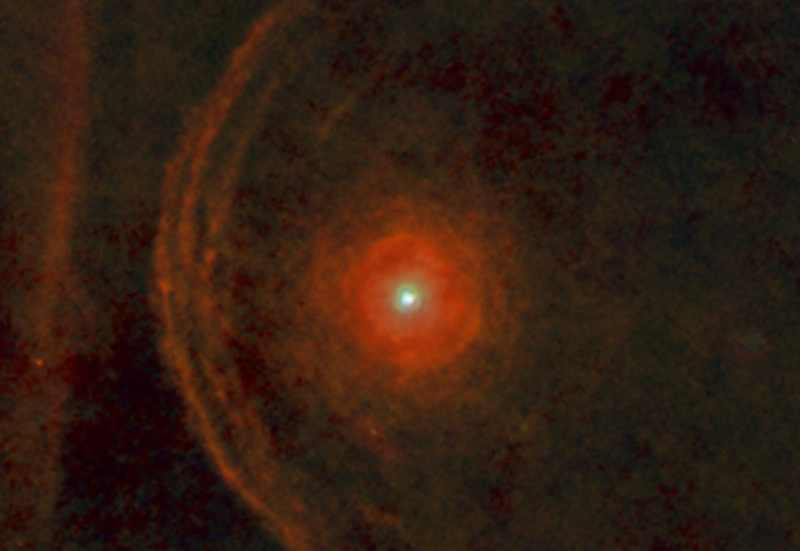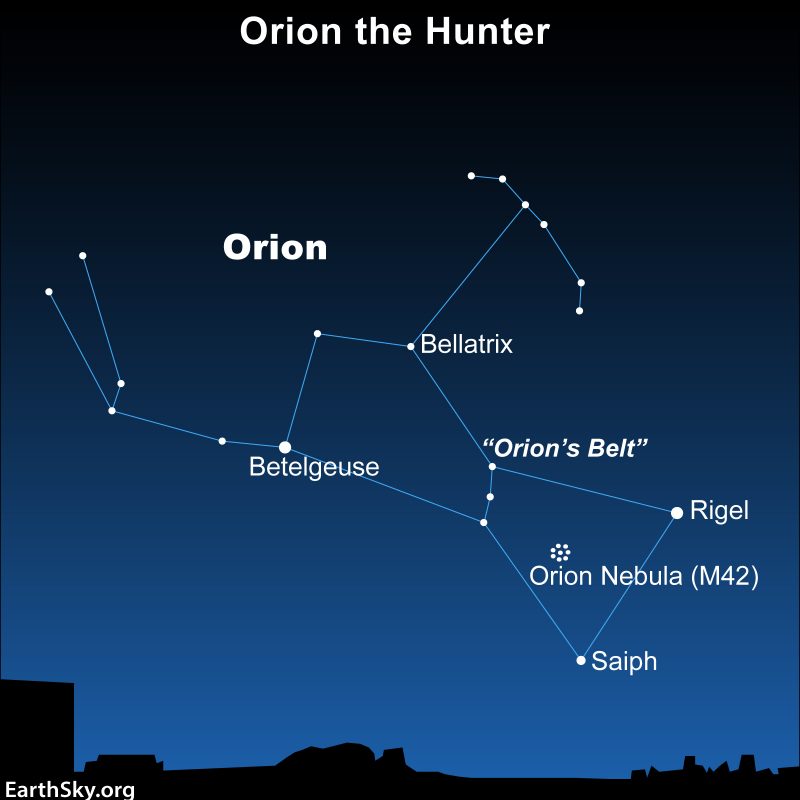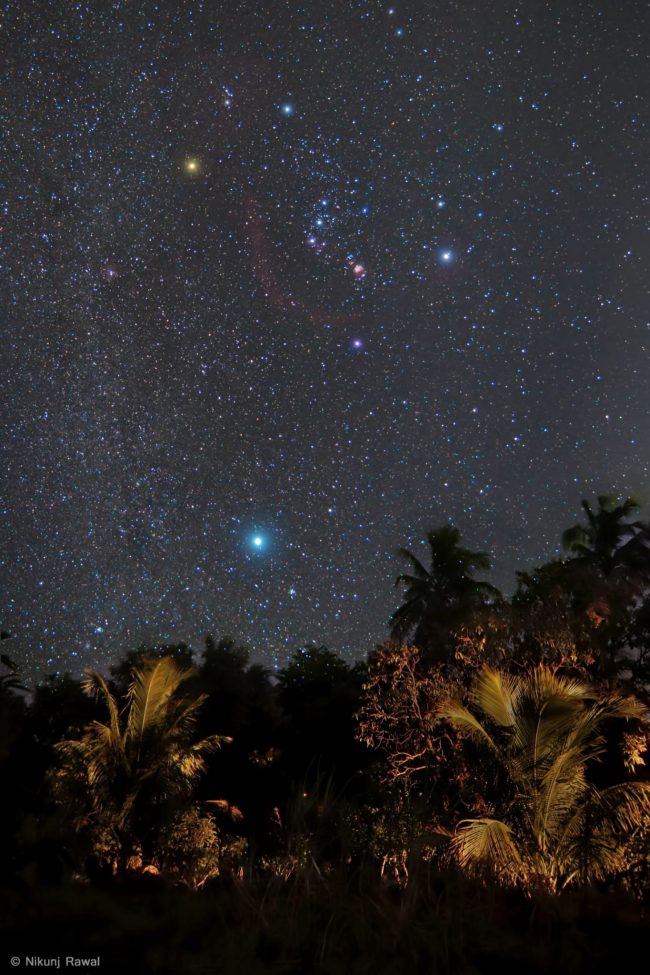
Betelgeuse is a supergiant star
Betelgeuse is the nearest red supergiant star to Earth. Someday it’ll explode as a supernova, but when? Just a few years ago, in late 2019, Betelgeuse sparked excitement around the world when it began dimming noticeably. The strange dimming of Betelgeuse caused some to believe the big event was close at hand. But Betelgeuse hasn’t exploded yet. This highly noticeable star in the constellation Orion the Hunter has since regained brightness, dimmed again, and brightened again, apparently now returning to a less active state. Clearly, though, more dimming could happen at any time.
Start watching Betelgeuse now, and you can keep an eye out for yourself. It’s easy to spot, as the second-brightest star in Orion, marking the Hunter’s right shoulder. Betelgeuse shines with a reddish hue. It’s well-placed for viewing in the evening sky during the first couple of months of every year.

Why did it suddenly dim?
Analyzing data from NASA’s Hubble Space Telescope and several other observatories, astronomers have concluded that the bright red supergiant star Betelgeuse quite literally blew its top in 2019. Betelgeuse lost a substantial part of its visible surface and produced a gigantic Surface Mass Ejection (SME). This is something never before seen in a normal star’s behavior.
Our sun routinely blows off parts of its tenuous outer atmosphere, the corona, in an event known as a Coronal Mass Ejection (CME). But the Betelgeuse SME blasted off 400 billion times as much mass as a typical CME!
Read more: Betelgeuse is recovering from blowing its top
So the strange dimming of Betelgeuse was apparently caused by a cloud of hot gas, expelled by the star, that temporarily blocked some of the star’s light.

Betelgeuse will explode … someday
Betelgeuse may lie as close as 724 light-years from Earth (although some estimates place it farther away; determining distances to red supergiant stars such as Betelgeuse is a vexing problem in astronomy). Betelgeuse is far away, yet it’s one of the brightest stars in Earth’s sky because it’s intrinsically very brilliant, some 100,000 times brighter than our own sun.
Such brilliance comes at a price because Betelgeuse’s enormous energy expends its fuel quickly, which hastens the end of its life. Someday “soon” the star will run out of fuel, collapse under its own weight, and then rebound in a spectacular supernova explosion. When this happens, Betelgeuse will brighten enormously for a few weeks or months, perhaps becoming as bright as the full moon, and be visible in broad daylight.
When will it explode? It probably won’t happen in our lifetimes. But, in fact, no one really knows when it will explode. It could happen tomorrow or a million years from now.
Will its supernova destroy Earth?
Whenever Betelgeuse does blow up, our planet Earth is too far away for this explosion to harm, much less destroy, life on Earth. Astrophysicists say we’d have to be within 50 light-years of a supernova for it to harm us and Betelgeuse is over 14 times this distance.
Instead, anyone alive on Earth when it happens will see an amazingly beautiful sight in the night sky – a very, very, very bright star.
Astronomers will be lucky to have Betelgeuse as close as it is so that they can study the star post-supernova.

Betelgeuse in the night sky
At mid-northern latitudes, around the first of every year, Betelgeuse rises around sunset. The star is prominent on January and February evenings.
By the beginning of March, this star is due south in early evening. By mid-May, it is briefly visible in the west after sunset. Betelgeuse is traveling behind the sun in early summer, but it returns to the east before dawn by about mid-July.
The star Betelgeuse has a distinctive muted orange-red color. It’s ideal for convincing non-believers that stars do, in fact, come in colors.
Stars designated as Alpha are typically brightest in their constellations. But Betelgeuse is Alpha Orionis, despite the fact that it’s fainter than Orion’s other bright star, Rigel.
Betelgeuse is the 10th brightest star in the sky overall, and it’s the seventh brightest star visible from most of the U.S., Canada, Europe and the majority of the Northern Hemisphere.
Check daily Betelgeuse status on Twitter
Pop culture, history and mythology
Remember the movie Beetlejuice? This star’s name is similar to that.
The proper names of many bright stars are Arabic in origin. This fact reflects the dominance of Arabic astronomers and astrologers during Europe’s Dark Ages. The name Betelgeuse is derived from an Arabic phrase that is usually translated as The Armpit of the Giant. Of course the Giant refers to Orion, but – rather than an armpit – some authors see Betelgeuse as representing a hand or sometimes a shoulder. While it is not entirely clear what the name means, Betelgeuse marks the right shoulder of Orion in many old star maps.
In the ancient myths, Orion is most often associated with a giant, a warrior, a hunter, a god or some other anthropomorphic or animal figure, so it is not surprising that most depictions of Betelgeuse have an anatomical connection. The Sanskrit name signified an arm, too, for example, although it likely was really the leg of a stag. In parts of Brazil, Betelgeuse was seen as the hind leg of a cayman (crocodilian) or the foreleg of a turtle. On the other hand, in ancient Japan, Betelgeuse was considered to be part of the rim of a ceremonial drum. In Peru, it was one of four vultures about to devour a criminal.
The position of Betelgeuse is RA 05h 55m 10.3053s, dec +07° 24′ 25.4″.
Bottom line: Betelgeuse is due to explode as a supernova someday, although maybe not soon on a human timescale. When it does explode, it’ll be bright enough from our earthly vantage point to shine during the day. But it’s far enough away that Earth won’t be in danger.
Read more: Colors of Betelgeuse in a star collage
The post Betelgeuse will explode someday first appeared on EarthSky.
from EarthSky https://ift.tt/Z8ruVjS

Betelgeuse is a supergiant star
Betelgeuse is the nearest red supergiant star to Earth. Someday it’ll explode as a supernova, but when? Just a few years ago, in late 2019, Betelgeuse sparked excitement around the world when it began dimming noticeably. The strange dimming of Betelgeuse caused some to believe the big event was close at hand. But Betelgeuse hasn’t exploded yet. This highly noticeable star in the constellation Orion the Hunter has since regained brightness, dimmed again, and brightened again, apparently now returning to a less active state. Clearly, though, more dimming could happen at any time.
Start watching Betelgeuse now, and you can keep an eye out for yourself. It’s easy to spot, as the second-brightest star in Orion, marking the Hunter’s right shoulder. Betelgeuse shines with a reddish hue. It’s well-placed for viewing in the evening sky during the first couple of months of every year.

Why did it suddenly dim?
Analyzing data from NASA’s Hubble Space Telescope and several other observatories, astronomers have concluded that the bright red supergiant star Betelgeuse quite literally blew its top in 2019. Betelgeuse lost a substantial part of its visible surface and produced a gigantic Surface Mass Ejection (SME). This is something never before seen in a normal star’s behavior.
Our sun routinely blows off parts of its tenuous outer atmosphere, the corona, in an event known as a Coronal Mass Ejection (CME). But the Betelgeuse SME blasted off 400 billion times as much mass as a typical CME!
Read more: Betelgeuse is recovering from blowing its top
So the strange dimming of Betelgeuse was apparently caused by a cloud of hot gas, expelled by the star, that temporarily blocked some of the star’s light.

Betelgeuse will explode … someday
Betelgeuse may lie as close as 724 light-years from Earth (although some estimates place it farther away; determining distances to red supergiant stars such as Betelgeuse is a vexing problem in astronomy). Betelgeuse is far away, yet it’s one of the brightest stars in Earth’s sky because it’s intrinsically very brilliant, some 100,000 times brighter than our own sun.
Such brilliance comes at a price because Betelgeuse’s enormous energy expends its fuel quickly, which hastens the end of its life. Someday “soon” the star will run out of fuel, collapse under its own weight, and then rebound in a spectacular supernova explosion. When this happens, Betelgeuse will brighten enormously for a few weeks or months, perhaps becoming as bright as the full moon, and be visible in broad daylight.
When will it explode? It probably won’t happen in our lifetimes. But, in fact, no one really knows when it will explode. It could happen tomorrow or a million years from now.
Will its supernova destroy Earth?
Whenever Betelgeuse does blow up, our planet Earth is too far away for this explosion to harm, much less destroy, life on Earth. Astrophysicists say we’d have to be within 50 light-years of a supernova for it to harm us and Betelgeuse is over 14 times this distance.
Instead, anyone alive on Earth when it happens will see an amazingly beautiful sight in the night sky – a very, very, very bright star.
Astronomers will be lucky to have Betelgeuse as close as it is so that they can study the star post-supernova.

Betelgeuse in the night sky
At mid-northern latitudes, around the first of every year, Betelgeuse rises around sunset. The star is prominent on January and February evenings.
By the beginning of March, this star is due south in early evening. By mid-May, it is briefly visible in the west after sunset. Betelgeuse is traveling behind the sun in early summer, but it returns to the east before dawn by about mid-July.
The star Betelgeuse has a distinctive muted orange-red color. It’s ideal for convincing non-believers that stars do, in fact, come in colors.
Stars designated as Alpha are typically brightest in their constellations. But Betelgeuse is Alpha Orionis, despite the fact that it’s fainter than Orion’s other bright star, Rigel.
Betelgeuse is the 10th brightest star in the sky overall, and it’s the seventh brightest star visible from most of the U.S., Canada, Europe and the majority of the Northern Hemisphere.
Check daily Betelgeuse status on Twitter
Pop culture, history and mythology
Remember the movie Beetlejuice? This star’s name is similar to that.
The proper names of many bright stars are Arabic in origin. This fact reflects the dominance of Arabic astronomers and astrologers during Europe’s Dark Ages. The name Betelgeuse is derived from an Arabic phrase that is usually translated as The Armpit of the Giant. Of course the Giant refers to Orion, but – rather than an armpit – some authors see Betelgeuse as representing a hand or sometimes a shoulder. While it is not entirely clear what the name means, Betelgeuse marks the right shoulder of Orion in many old star maps.
In the ancient myths, Orion is most often associated with a giant, a warrior, a hunter, a god or some other anthropomorphic or animal figure, so it is not surprising that most depictions of Betelgeuse have an anatomical connection. The Sanskrit name signified an arm, too, for example, although it likely was really the leg of a stag. In parts of Brazil, Betelgeuse was seen as the hind leg of a cayman (crocodilian) or the foreleg of a turtle. On the other hand, in ancient Japan, Betelgeuse was considered to be part of the rim of a ceremonial drum. In Peru, it was one of four vultures about to devour a criminal.
The position of Betelgeuse is RA 05h 55m 10.3053s, dec +07° 24′ 25.4″.
Bottom line: Betelgeuse is due to explode as a supernova someday, although maybe not soon on a human timescale. When it does explode, it’ll be bright enough from our earthly vantage point to shine during the day. But it’s far enough away that Earth won’t be in danger.
Read more: Colors of Betelgeuse in a star collage
The post Betelgeuse will explode someday first appeared on EarthSky.
from EarthSky https://ift.tt/Z8ruVjS

Aucun commentaire:
Enregistrer un commentaire